Kolumbien |
|
|
|
| Übersicht – Contents: | |
Kolumbien |
|
|
|
| Übersicht – Contents: | |
Flaggen – Flags: |
|
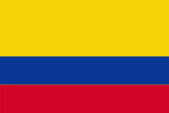 |
Nationalflagge – national flag, Seitenverhältnis – ratio = 2:3, Quelle/Source: Corel Draw 4   |
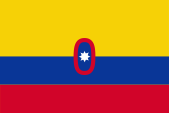 |
Handelsflagge – merchant flag, Seitenverhältnis – ratio = 2:3, Quelle/Source: Corel Draw 4 |
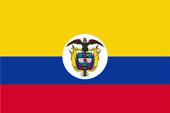 |
Marineflagge – naval flag, Seitenverhältnis – ratio = 2:3, Quelle/Source: Flaggen und Wappen |
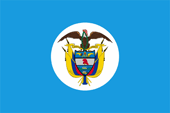 |
Gösch – jack, Seitenverhältnis – ratio = 2:3, Quelle/Source, nach/by: Wikipedia (DE) |
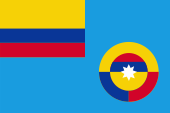 |
Flagge der Luftwaffe – flag of the Air Force, Seitenverhältnis – ratio = 2:3, Quelle/Source, nach/by: Flags of the World |
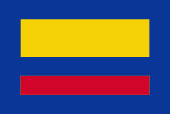 |
Zollflagge – customs flag, Seitenverhältnis – ratio = 2:3, Quelle/Source, nach/by: Flags of the World, Flaggenbuch 1939 |
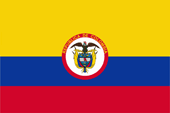 |
Präsidentenflagge – flag of the president, Seitenverhältnis – ratio = 2:3, Quelle/Source, nach/by: Flags of the World  |
historische Flaggen – historical Flags: |
|
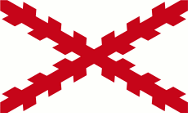 |
1538–1717, Flagge Königreich Neu-Spanien – flag of the Kingdom of New Spain, Quelle/Source, nach/by: Wikipedia (ES) |
 |
1717–1785, Flagge Vize-Königreich Neu-Granada – flag of the Vice-Kingdom of New Granada, Quelle/Source, nach/by: Wikipedia (EN) |
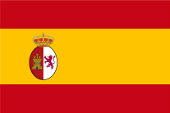 |
1785–1819, Flagge Vize-Königreich Neu-Granada – flag of the Vice-Kingdom of New Granada, Quelle/Source, nach/by: Wikipedia (EN) |
 |
1806–1815, Flagge der aufständischen Regierung flag of the insurgent government |
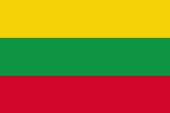 |
1814–1816, Nationalflagge – national flag, Quelle/Source, nach/by: Wikipedia (EN)  |
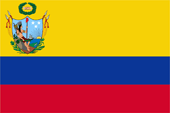 |
1819, |
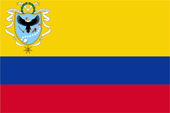 |
1820, |
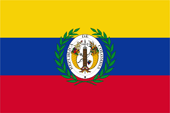 |
1821–1831, |
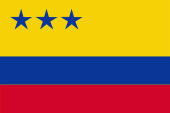 |
1822–1830, |
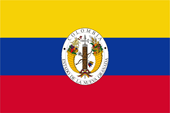 |
1831–1834, |
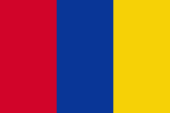 |
1834–1861, |
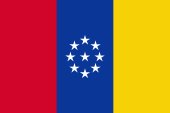 |
1861, |
Bedeutung/Ursprung der Flagge – Meaning/Origin of the Flag: |
|
| Die Flagge Kolumbiens – in den Farben Gelb, Blau und Rot, und exat im heutigen Design – wurde 1806 durch Francisco de Miranda (1750–1816) eingeführt. | The flag of Colombia – in the colours yellow, blue and red and exactly in the today's design – was in 1806 introduced by Francisco de Miranda (1750–1816). |
| Der breite gelbe Streifen sollte dazu dienen irgendwann ein Wappen oder eine raumgreifende Allegorie aufzunehmen. | The wide yellow stripe should serve at some point in time to pick up a coat of arms or a room-sizing allegory. |
| Seit dem Beginn des 19. Jahrhunderts wurde diese Flagge in verschiedenen, leicht abgewandelten Formen verwendet. Erstmals war sie bereits im Jahre 1807 bei einem Feldzug der Befreiungsarmee gegen Ortschaften im Norden Venezuelas in Gebrauch. | Since the beginning von the 19th century the flag was used in various some changed designs. For the first time it was in use already in the year 1807 during a campaign of the liberation army against places in the north of Venezuela. |
| Die
Farben Gelb, Blau und Rot sollen die Trennung des Landes (Landesfarbe: Gelb)
von der Kolonialmacht Spanien (Landesfarbe: Rot) durch das Meer (Blau)
symbolisieren. Gelb steht auch für den Reichtum des Landes, für den Sonnenschein und die Kornfelder. Blau steht für den Himmel, den Ozean und die Flüsse, und Rot steht für das für die Unabhängigkeit vergossene Blut. |
The colours yellow, blue and red should symbolize the separation of the country (colour of the country: yellow) from the colonial might of Spain (colour of the country: red) by the ocean (blue). Yellow stands as well for the wealth of the country, for the sunshine and the grain fields. Blue stands for the heaven, the ocean and the rivers, and red symbolizes the for the independence given blood. |
| Ekuador und Venezuela verwenden ähnliche Flaggen, ein Hinweis auf die einstige historische Vereinigung der Länder Ekuador, Venezuela und Kolumbien innerhalb Großkolumbiens. | Ecuador and Venezuela use similar flags, a hint at the once historical unification of the countries Ecuador, Venezuela and Colombia within Great Colombia. |
| Die Flagge geht in ihre Farben auf Johann Wolfgang von Goethe zurück, der eine eigene Farbenlehre entwickelt hatte und Miranda 1785 in Weimar mit seinen Vorstellungen von Farben und ihren psychologischen Wirkprinzipien aufmerksam machte, und Gelb, Blau und Rot als die hauptsächlich vom Menschen wahrgenommenen Farben beschrieb. Miranda wählte als Farben Gelb, Blau und Rot. Häufig wird unterstellt, dass Miranda "Hellblau" gewählt hätte, was auch auf einigen Flaggendarstellungen aus dieser Region und Zeit zu finden ist. Das ist problematisch. Flaggen als historische Fundstücke werden oft mit dem modernen Auge betrachtet, und schnell wird eine bestimmte Farbbezeichnung verwendet. Dabei wird völlig ignoriert, dass das Hellblau auf Auswaschen und Verbleichen zurückzuführen ist, eine bei Indigo (einen anderen Farbstoff gab es damals noch nicht) bis heute bekannte und auch entsprechend ausgenutzte Eigenschaft. |
The colours of the flag go back to Johann Wolfgang von Goethe, who had
developed his own theory of colors and drew Miranda's attention in Weimar in
1785 with his ideas about colors and their psychological principles of
action, and described yellow, blue and red as the colors mainly perceived by
humans. Miranda chose yellow, blue and red as colours. It is often assumed that Miranda would have chosen "light blue", which can also be found on some flag representations from this region and time. This is problematic. Flags as historical finds are often viewed with the modern eye, and a specific color designation is quickly used. That ignores completely the fact that the light blue is due to washout and bleaching, a property known to Indigo (no other dye was known at that time) until today and also suitably exploited. |
| 1815 entschied man sich den Kampf gegen Spanien unter Flaggen in den Farben Gelb, Grün und Rot fortzusetzen. | 1815 thay decided to continue the struggle against Spain under flags in the colours yellow, green and red. |
| Im Jahre 1819 schlossen sich die Vereinigten Provinzen von Neugranada (das spätere Kolumbien) mit den Provinzen Quito (Ekuador) und Venezuela unter der Führung von Simón Bolívar zur Republik Großkolumbien zusammen. Dabei wurden die Farben Gelb, Blau und Rot wiederbelebt und für die Flagge des Landes übernommen, wieder mit dem breiten gelben Streifen, der jetzt in der Oberecke eine Allegorie mit einem sitzenden Indianer zeigte. Schon nach einem Jahr wurde das Wappen geändert, das blaue Schild zeigte jetzt einen Condor und mehrere Sterne. Nach einem Jahr, im Jahre 1821, wurde das Wappen wieder geändert. Es war jetzt eine Art Kartusche, die ein Liktorenbündel und zwei Füllhörner zeigte und ringsum den Namen des Landes. Es war jetzt in der Mitte der Flagge platziert, die nun drei gleich breite Streifen hatte. Dies Flagge wurde bis zum Ende Großkolumbiens im Jahre 1830 beibehalten. Das Land zerfiel nach dem Tod von Simón Bolívar in die Staaten Neugranada, Venezuela und Ekuador. | In
1819, the United Provinces of Neugranada (the later Colombia) merged with
the provinces of Quito (Ecuador) and Venezuela under the leadership
of Simón Bolívar to form the Republic of Great Colombia. On this occasion,
the colors yellow, blue and red were revived and taken over for the
flag of the country, again with the wide yellow stripe, which now showed
an allegory in the upper corner with a sitting Indian. After only one year the coat of arms was changed, the blue shield showed now a Condor and several stars. After one year, in 1821, the coat of arms was changed again. It was now a kind of a cartridge, showing a bundle of lictors and two filler horns and all around the name of the country. It was now placed in the middle of the flag, which now had three equally wide stripes. This flag was retained until the end of Great Colombia in 1830. The country disintegrated into the states of Neugranada, Venezuela and Ecuador after the death of Simón Bolívar. |
| Die Flagge Großkolumbiens wurde jedoch in der Praxis häufig ohne Wappen verwendet, das Obereck war ergänzt um drei blaue Sterne. Diese standen für die drei Provinzen Neugranada, Venezuela und Quito. Offenbar war diese Flagge leichter herzustellen. | The flag of Great Colombia, however, was commonly used in practice without a coat of arms, the upper corner was supplemented by three blue stars. These stood for the three provinces of Neugranada, Venezuela and Quito. Apparently, this flag was easier to make. |
| Das nach der Abtrennung von Ekuador und Venezuela verbleibende Restkolumbien nannte sich jetzt Neugranada, behielt jedoch die Flagge Großkolumbiens bei, nur wurde der Name des Landes in der Umschrift des Wappens geändert. | The after the separation of Ecuador and Venezuela remaining Colombia now called themselves New Granada, but retained initially the flag of Great Colombia, only the name of the country was changed in the transcription of the coat of arms. |
| Diese Flagge wurde nur bis 1834 verwendet. Danach wurden die Farben Gelb, Blau und Rot senkrecht angeordnet, ohne Wappen. Mit der Proklamation der Vereinigten Staaten von Kolumbien wurde im Jahr 1861 der blaue Mittelstreifen vier Monate lang um acht weiße Sterne ergänzt, die kreisförmig um einen neunten Stern in der Mitte angeordnet waren. Danach wurde wieder die Flagge von 1806 eingeführt, und bis heute beibehalten. | This flag was only in use until
1834. Thereafter the colours yellow,
blue and red were arranged verticaly, without coat of arms. In occasion of the proclamation of the United States of Colombia in the year 1861 the blue middle-stripe was supplemented for four month by eight white stars which were arranged circularily around a ninth star in the middle. Then was adoped again the flag of 1806 and maintained until today. |
| In ihrer heutigen Gestalt wurde die Flagge am 26.11.1861 durch einen Beschluss des Präsidenten exakt definiert. Sie zeigt drei waagerechte Streifen in Gelb, Blau und Rot im Verhältnis 2:1:1. Der verbreiterte gelbe Streifen sollte wieder Platz für Wappen oder allegorische Darstellungen bieten, wovon aber bis heute kein Gebrauch gemacht wird. Wenn Wappen oder ähnliches vorkommen, sind diese in der Mitte der Flagge platziert. Die Farben der Flagge sind heute definiert als Gelb = Pantone 116, Blau = Pantone 287 und Rot = Pantone 186. Das auf einigen Flaggen auftretende Hellblau ist als Pantone 2925 anzunehmen. Für historische Flaggen gilt das natürlich nicht, dartige Standards gab es damals noch nicht. Für die Darstellung der historischen Flaggen wurden auf dieser Webseite trotzdem die modernen Standards angewendet. | In its
today's design the flag was precisely defined on 26th of November in 1861 by a
decision of the president. It shows three horizontal stripes in yellow, blue and red in proportion 2:1:1. The widen yellow stripe should give space again for coats of arms or allegorical depictions, but this was not used until today. If coats of arms or similar things occur, they are placed in the middle of the flag. The colours of the flag today are defined as yellow = Pantone 116, blue = Pantone 287 and red = Pantone 186. The light blue that appears on some flags is assumed to be Pantone 2925. Of course, this does not apply to historical flags, as such standards did not exist at that time. Nevertheless, the modern standards were used for the representation of the historical flags on this website. |
| Quelle/Source: Die Welt der Flaggen, Volker Preuß, Wikipedia (EN) | |
Wappen – Coat of Arms: |
|
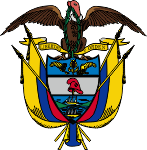 |
Wappen von Kolumbien – coat of arms of Colombia, Quelle/Source: Corel Draw 4 |
Bedeutung/Ursprung des Wappens – Meaning/Origin of the Coat of Arms: |
|
| Das Staatswappen stammt in seinen Grundstrukturen aus dem Jahre 1832, wurde jedoch immer wieder – zuletzt im Jahre 1955 – leicht abgeändert. Es zeigt auf einem von Flaggen umgebenen Schild zwei Füllhörner, einen Granatapfel und eine phrygische Mütze, darunter die Landenge von Panama, die bis 1903 zu Kolumbien gehörte. Der Granatapfel erinnert an den früheren Landesnamen "Neugranada". Oberhalb des Schilds ein Kondor, der Nationalvogel des Landes, und ein goldenes Spruchband mit dem Landesmotto: "Libertad y Orden" → "Freiheit und Ordnung" | The coat
of arms of the state is in its fundamental structures from the year 1832,
but was again and again – finally in the year 1955 – few changed. It shows on a by flags surrounded shield two cornucopias, a pomegranate and a Phrygian cap, underneath the Isthmus of Panama, which belonged until 1903 to Colombia. The pomegranate remembers the former name of the country "Neugranada". Above the shield a condor, the national bird of the country, and a golden banner with the motto of the state: "Libertad y Orden" → "Freedom and Order" |
| Quelle/Source: Flaggen Wappen Hymnen | |
Flugzeugkokarde – aircraft roundel: |
|
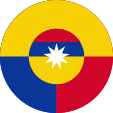 |
1927–1953, Flugzeugkokarde – aircraft roundel Quelle/Source, nach/by: Wikipedia (EN) |
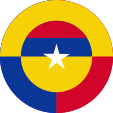 |
seit/since 1953, Flugzeugkokarde – aircraft roundel Quelle/Source, nach/by: Wikipedia (EN) |
Landkarte – Map: |
Lage – Position: |
Landkarte des Landes – Map of the Country: |
|
|
Zahlen und Fakten – Numbers and Facts: |
|
|
|
|
|
|
|
|
|
|
|
|
|
|
|
|
|
|
|
Geschichte: |
| ca. 200
v.Chr.–ca. 500 n.Chr · Calima-Kultur im zentralen Bergland ca. 1000 n.Chr.–ca. 1600 · Tairona-Kultur im Norden des Landes 1499 · der Spanier Alonso de Ojeda entdeckt die Küste Kolumbiens 1505 · Beginn der Spanischen Erkundung 1525 · Beginn der spanischen Kolonisierung 1528–1556 · der Norden des heutigen Venezuela ist im Besitz der deutschen Familie Welser 1536–1539 · Spanien erobert ganz Kolumbien und zerstört 1538 das Reich der Chibcha im Hochland 1739 · Bildung des Vizekönigreichs Neugranada, welches die heutigen Staaten Kolumbien, Venezuela, Ekuador und Panama umfasst 1781 · großer anti-spanischer Aufstand 20.07.1810 · Proklamation der Unabhängigkeit von Spanien 1810–1819 · Unabhängigkeitskrieg gegen Spanien unter der Führung von Simón Bolívar 1819 · Proklamation der Republik Großkolumbien (ehemaliges Vizekönigreich Neugranada) 1830 · Venezuela und Ekuador spalten sich durch Bürgerkriege von Großkolumbien ab, Großkolumbien wird in Republik Neugranada umbenannt 1856 · militärische Intervention der USA 1858 · die Republik Neugranada wird in Granadische Konföderation umbenannt 1860 · militärische Intervention der USA 1861 · Proklamation der Vereinigten Staaten von Kolumbien 1885 · militärische Intervention der USA 1886 · Proklamation der Republik Kolumbien 1891–1896 · Grenzstreitigkeiten mit Venezuela 1895 · militärische Intervention der USA 1899–1903 · Bürgerkrieg 1901–1902 · militärische Intervention der USA 1903 · die Provinz Panama spaltet sich auf Betreiben der USA von Kolumbien ab und erklärt ihre Unabhängigkeit 1921 · Kolumbien erkennt die Unabhängigkeit von Panama an 1931–1942 · Grenzstreitigkeiten mit Peru 1948–1953 · Bürgerkrieg („violencia“) 1953–1957 · Militärdiktator unter G. Rojas Pinilla 1965–2004 · Bürgerkrieg zwischen rivalisierenden Milizen, den kommunistischen Gruppen FARC und ELN, Drogenkartellen und der Regierung 1991 · neue Verfassung 2016/2017 · Versuche von Friedensabkommen zwischen der Regierung und FARC und ELN |
History: |
| ca. 200
B.C.–ca. 500 A.D. · Calima Civilization in the central highlands ca. 1000 A.D.–ca. 1600 · Tairona Civilization in the north of the country 1499 · the Spaniard Alonso de Ojeda discoverd the coast of Colombia 1505 · beginning of the Spanish exploration 1525 · beginning of the Spanish colonization 1527–1546 · the north of the today's Venezuela is in ownership of the German family of Welser 1536–1539 · Spain conquers whole Colombia and destroys in 1538 the Empire of the Chibcha in the highlands 1739 · formation of the Vice-Kingdom of New Granada, which includes the today's countries Colombia, Venezuela, Ecuador and Panama 1781 · great anti-Spanish revolt 20th of July 1810 · proclamation of the independence from Spain 1810–1819 · independence war against Spain under leadership of Simón Bolívar 1819 · proclamation of the Republic of Great Colombia (former Vice-Kingdom of New Granada) 1830 · Venezuela and Ecuador separate themselves by civil wars from Great Colombia, Great Colombia gets renamed in Republic of New Granada 1856 · military intervention of the USA 1858 · the Republic of New Granada gets renamed in Granadian Confederation 1860 · military intervention of the USA 1861 · proclamation of the United States of Colombia 1885 · military intervention of the USA 1886 · proclamation of the Republic of Colombia 1891–1896 · frontier-quarrels with Venezuela 1895 · military intervention of the USA 1899–1903 · civil war 1901–1902 · military intervention of the USA 1903 · the Province of Panama separates itself at the instigation of the USA from Colombia and declares its independence 1921 · Colombia recognizes the independence of Panama 1931–1942 · frontier-quarrels with Peru 1948–1953 · civil war („violencia“) 1953–1957 · military dictatorship under G. Rojas Pinilla 1965–2004 · civil war between rival militias, the communist groups FARC and ELN, drug cartels and the government 1991 · new constitution 2016/2017 · attempts at peace agreements between the government and FARC and ELN |
| Quelle/Source: Atlas zur Geschichte, Wikipedia (D), Discovery '97, Weltgeschichte |
Ursprung des Landesnamens – Origin of the Country's Name: |
|
| Der Name des Landes ist eine Reminszenz auf Christoph Kolumbus, der im Jahre 1492 Amerika entdeckt hat. | The name of the country is a reminiscence of Christopher Columbus, who discovered America in 1492. |
| Quelle/Source: Handbuch der geographischen Namen | |